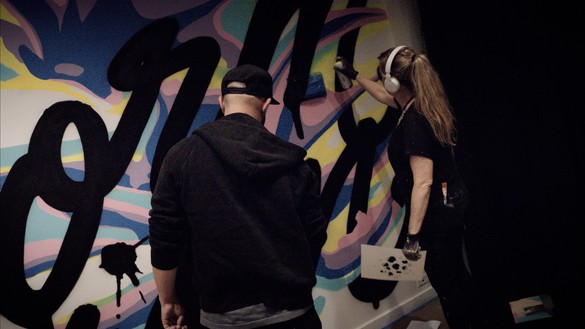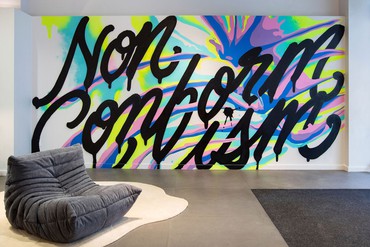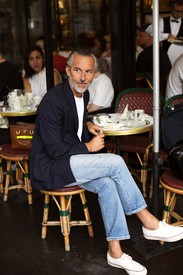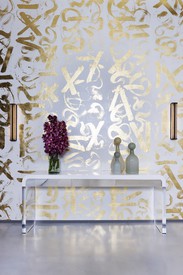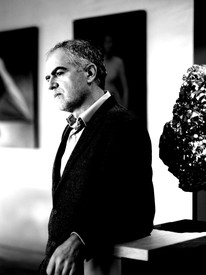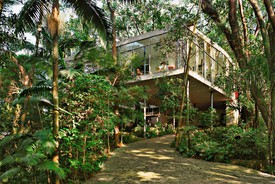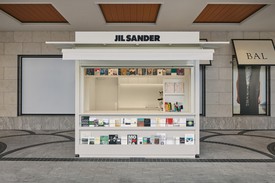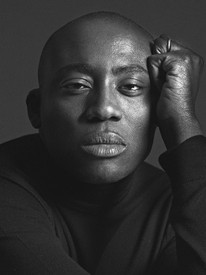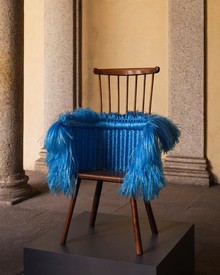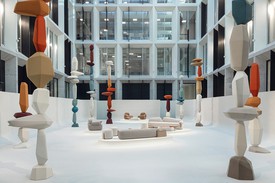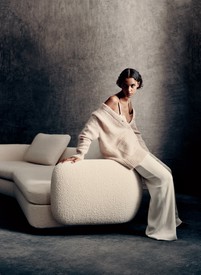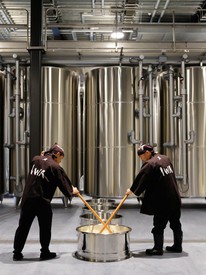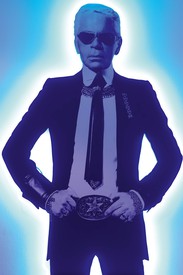
Wyatt Allgeier is a writer and an editor for Gagosian Quarterly. He lives and works in New York City.
Wyatt AllgeierThank you both for taking time to speak about this project. To begin, could each of you tell us how you first came to art making, specifically art directed toward large public engagement? What drew you to your medium, and how did you build your practice and skill set?
VextaLike most artists, I was always drawing and painting as a child. I was living in Melbourne after finishing university, and it was around the time that the stencil and graffiti scene was starting to explode there. I was hanging around with other artists, and we started taking over empty buildings and hosting illegal art exhibitions in them before they got demolished. We would sneak in and paint big pieces on the walls and do all kinds of crazy installations. I started mixing up spray paint and acrylic, teaching myself to paint, creating my own symbolic language and thinking about the type of work I wanted to share with the world.
These early illegal exhibitions were formative and a real tangible and immediate way for me to create art and have an instant dialogue with the public. I realized the power of public art, and I was hooked.
FAUSTAs a young artist growing up in New York City, I was intrigued by the graffiti that surrounded me. The inherently rebellious culture appealed to me as an adolescent, and before the age of social media, I didn’t know a better way to make a name for myself in a city of eight million people than to just get up. One’s signature, their tag, is the fundamental element in graffiti. While other writers were trying to burn (outdo) each other by creating the most elaborate murals and colorful pieces, I focused on handstyle and believed a perfectly executed tag could display far more confidence and feel much more elegant and sophisticated. I lifted a tag from the street corner and blew it up to architectural scale to challenge the way graffiti was perceived. And after making this gesture my signature style, I then broke away from just writing my own name and strove to find words and phrases that were clever, poignant, and site-specific to resonate with the community. Graffiti engages in public discourse, but more often than not the primary impetus of the artist is branding and self-promotion. I really found my own voice when I looked beyond that and realized the power my work had to speak for others.
WAIn terms of aesthetics, where do you look for inspiration? The type of work that each of you does brings together art history, graphic design, typography, and the specific legacy of street art—how did you come to define your unique voice between these worlds?
FFirst and foremost, my work is rooted in the history of New York graffiti culture, and I hope to carry on that lineage, but you’re right about there being a myriad of other influences. My larger-than-life lettering is just as much indebted to Barbara Kruger and Paula Scher as it is to Stay High 149. I see the poetic nature of my work more closely tied to the canon of text-based artists (Ed Ruscha, Christopher Wool, Jenny Holzer, Lawrence Weiner, and others), seen through the lens of the culture I grew up in and an aesthetic that I identify with as a reflection of my generation.
VI’m inspired by the patterns found in nature, distilling them down into their parts and looking at their similarities. For example, the repetition found in coral and fungi, or subatomic particles and dark matter . . . it’s really psychedelic! By using a combination of abstraction and figurative images, I like to explore how we relate to the natural world around us. This is what I did for our piece with Ligne Roset. I took a photo of a Togo chair and zoomed into the folds of the fabric and then pulled these elements apart until they were almost abstracted. When it comes to defining my creative voice, I try to create what I want to see in the world, to think about my perspective and experiences: what I can bring to the table that is unique to me, yet can resonate with an audience. I’m looking for the personal in the universal.
Video: Sebastien Vergne
WAFor this project with Ligne Roset, what were your initial concepts and considerations when you were approached with this opportunity? Was this your first time collaborating together? How did you negotiate the partnership and arrive at the final work on Park Avenue South?
FWe’ve collaborated once before, but that was a much different experience, where our work complemented each other’s on adjacent walls, as opposed to finding balance on the same canvas. This was particularly challenging because it was almost like a three-way collaboration. Taking inspiration from the organic contours of Ligne Roset’s Togo design, I gravitated to the rounded, flowing letters in my “drip script” style as opposed to the hard edges and sharp points that my letterforms have when using a chisel-tip marker. I broke up the word to fill the entire wall while also leaving a fair amount of negative space to allow Vexta’s work to show through.
VConceptually I thought about the story of the Togo as it relates to the toothpaste tube, so I wanted to evoke a viscous quality using very street aesthetics; I wanted to take the tiny details of the folds in the chair and enlarge them and give them movement as a nod to smearing and splashing paste. FAUST and I went back and forth discussing ideas until we landed on the concept together. We have been good friends for many years—we really wanted the piece to be read as one work of art, so figuring out how to literally weave FAUST’s lettering with my figurative work was a challenge that we were both excited to try. I’m really happy with how it all came together.
WAI’d love to hear you both address the aspect of scale. You’ve worked on projects from the most precious to the most monumental—how does the site-specificity of a project factor into the steps and compositional choices you make?
FIt’s typically dictated by the space, in both composition as well as content. Challenging the conventions of scale was a major breakthrough in my work. Not long ago I saw Hank Willis Thomas describe Claes Oldenburg’s work as making the quotidian monumental, and that resonated with me. Tags are commonplace in nearly every major city in the world. Instead of their just being seen and easily dismissed, through exploring scale and placement an observer is more likely to appreciate the formal qualities and perhaps reflect upon the meaning. I think my work is strongest when it towers over the viewer and creates an immersive experience that almost becomes abstract when viewed up close. That being said, it’s inherent to graffiti to be applied to any surface, so even if it’s a T-shirt collaboration with Comme des Garçons or embroidered onto the side of a Nike sneaker, I’m thinking about the medium, the audience, and how I can adapt my work to this unique opportunity and use it as a vehicle to share stories that are meaningful.
VThe site is super important to public art and murals. I examine such things as the direction that someone might view the art, the flow of foot traffic, the placement of the sun and light, trees, as well as local mythology. I love it when you can play with all those elements or have some synchronicity occur. I once painted a huge four-story mural in Malaysia. The image was of a woman whose hair turned into branches with birds flying in and out. Right next door was a temple. Every night birds and bats would fly past my mural at dusk, bringing the imagery to life. I had no idea that was going to happen!
WAI understand that this work with Ligne Roset was specifically inspired by New York City’s long tradition of graffiti art. Are there particular artists from this history you have been inspired by or tried to model your life after?
FI believe that relationship originally came about looking at the correlation between the fiftieth anniversary of the Togo chair design and the fiftieth anniversary of hip-hop. When you’re talking about the ’70s, the three aerosol artists I credit for being the most instrumental in the development of the art form are Phase 2 (RIP), RIFF 170, and Tracy 168. These are the architects who laid the foundation, developing bubble letters, arrows, clouds, drips, etc. Evolving style into wildstyle. Although I’m not part of that generation, I’m extremely fortunate to call RIFF and Tracy longtime friends and have spent countless hours learning from their experience and absorbing the oral history they’ve been generous to share with me. And more recently, artists like Futura, Stash, and Haze have been major influences—exemplifying how to elevate a graffiti career into a professional practice. These guys are each world-class artists and global brands. Their influence cannot be overstated. It’s rare for me to have a project that these guys haven’t already done a decade before me.
VBoth myself and FAUST have been active in the scene here for some time. I grew up in Australia and really cut my teeth in the graffiti and street art scene in Melbourne. I was one of the first women in the scene there and globally, so there weren’t a lot of women for me to look up to; Fafi and Miss Van were for sure the pioneers I looked to. I was hugely inspired by the scene that was going on in New York during Warhol’s Factory reign. I remember learning about that time and wishing I was born earlier so I could have moved to New York then. I love the way that the graffiti art scene has always been interwoven with other experimental creative scenes.
WAWhat does “nonconformism” mean to each of you?
VNonconformism means being experimental, pushing against the rules, embracing rebellion as a path to creation.
FNonconformism means being true to yourself, especially when it’s unconventional. Life is short, break the rules.
FAUST and Vexta: Nonconformism, Ligne Roset, 250 Park Avenue South, New York, May 19–December 31, 2023
Photos and video: courtesy Ligne Roset
